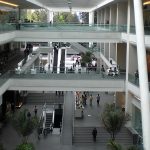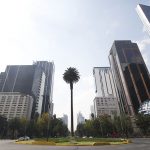
The Torre Mayor was the lone skyscraper on its end of Paseo de la Reforma for 12 long years. Today, Mexico City residents by and large give it the respect it’s due, even despite its taller and flashier neighbors.
The tower is among the most well documented of skyscrapers, in some part, because doubts existed as to whether a building of this scale could be accomplished. It was. And it was the only one for many years.
Although the photo above shows that the neighborhood of the Torre Mayor has gotten a lot more crowded, the Torre Mayor was still the first. For many, it will stand alone as one of the true forerunners. The tower’s place in the sky is secure even while its place in the skyline gets a little harder to see.
 info@torremayor.com.mx
info@torremayor.com.mx
 (55) 5283 8000
(55) 5283 8000
 http://www.torremayor.com.mx/
http://www.torremayor.com.mx/

Mexico's national auditorium for performance, opera, and every kind of music...

Shopping, or just a quick break, it's one of Mexico City's best-placed shopping centers.

One of the most ephemeral of Reforma roundabouts, La Palma is likely to make any list of favorites.